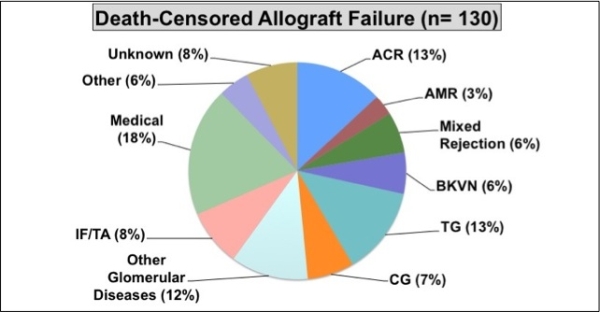Acute Rejection: A Major Cause of Death-Censored Kidney Allograft Failure.
1Weill Medical College of Cornell University, New York
2The Rogosin Institute, New York.
Meeting: 2016 American Transplant Congress
Abstract number: A243
Keywords: Graft failure, Rejection
Session Information
Session Name: Poster Session A: Long Term Outcomes in Kidney Transplantation
Session Type: Poster Session
Date: Saturday, June 11, 2016
Session Time: 5:30pm-7:30pm
 Presentation Time: 5:30pm-7:30pm
Presentation Time: 5:30pm-7:30pm
Location: Halls C&D
Introduction:
The role of acute rejection as a cause of kidney allograft failure is not well defined in the current era of immunosuppression. We analyzed the causes of death-censored kidney allograft failure at our center to further define the contribution of acute rejection.
Methods:
We transplanted 1670 patients at our center between 2001-2011. There were 189 death-censored allograft failures during this time period. After excluding patients with primary non-function, allograft thrombosis and those with incomplete follow up, the remaining 130 patients were matched to 130 controls with functioning allograft. The cases and controls were matched 1:1 for recipient age, donor type (living or deceased) and year of transplant. We determined the cause of allograft failure in each case by reviewing medical records and findings of the last available biopsy. The causes of allograft failure were divided into 9 categories: (I) acute rejection (II) BK nephropathy (III) transplant glomerulopathy (IV) collapsing glomerulopathy (V) other glomerular diseases (VI) interstitial fibrosis/tubular atrophy (VII) medical causes (VIII) others (IX) unknown.
Results:
Acute rejection was a major cause of death-censored allograft failure in our study accounting for 22% of the cases. The odds of having any ACR or AMR episode were 11.3 and 11.5 times higher in cases compared to controls using conditional logistic regression analysis. Recipient gender, recipient race, primary kidney disease, peak/current PRA ≥ 50%, number of HLA mismatches, number of prior transplants, BMI ≥ 30, donor gender, donor age, donor race, immunosuppression, DGF, BK viremia and CMV viremia were all not statistically different between cases and controls. 87% of patients received Thymoglobulin and 9% received Basiliximab induction. 31% of patients were on steroid maintenance regimen at the time of discharge. The median follow up in the cases and controls was 29.4 months and 62.3 months, respectively.
 .
.
Conclusion:
Acute rejection, cellular rejection in particular, continues to remain an important cause of allograft failure in the current era of immunosuppression.
CITATION INFORMATION: Alkadi M, Kim J, Hartono C, Aull M, Muthukumar T. Acute Rejection: A Major Cause of Death-Censored Kidney Allograft Failure. Am J Transplant. 2016;16 (suppl 3).
To cite this abstract in AMA style:
Alkadi M, Kim J, Hartono C, Aull M, Muthukumar T. Acute Rejection: A Major Cause of Death-Censored Kidney Allograft Failure. [abstract]. Am J Transplant. 2016; 16 (suppl 3). https://atcmeetingabstracts.com/abstract/acute-rejection-a-major-cause-of-death-censored-kidney-allograft-failure/. Accessed December 14, 2025.« Back to 2016 American Transplant Congress
